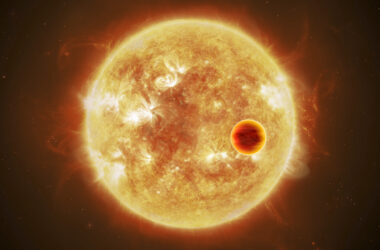In a remarkable discovery, the European Space Agency’s Euclid space telescope has captured a stunning image of an “Einstein ring” – a rare cosmic phenomenon that offers a glimpse into the warping of space-time.
These findings, announced in February 2025, mark a significant milestone in Euclid’s six-year mission to map out the dark universe and unravel the mysteries of dark matter and energy.

An Einstein ring is a direct consequence of gravitational lensing, a concept predicted by Albert Einstein’s general theory of relativity. It occurs when light from a distant galaxy is bent and magnified by the gravitational field of a massive foreground object, such as another galaxy or galaxy cluster. If the alignment is perfect, the light forms a complete ring around the foreground object, creating a breathtaking cosmic spectacle.
Euclid’s latest discovery revolves around NGC 6505, a galaxy located approximately 590 million light-years from Earth. While NGC 6505 has been studied since the 19th century, the Einstein ring surrounding its centre has never been observed. The ring’s visibility is a testament to Euclid’s high resolution and sensitivity, allowing it to detect the phenomenon hidden in plain sight.
The Einstein ring’s light source is a more distant galaxy, located 4.42 billion light-years away, directly behind NGC 6505 from Earth’s perspective. The immense gravitational field of NGC 6505 acts as a cosmic lens, bending and magnifying the light from this background galaxy to form the picturesque ring.
The Physics of Einstein Rings
Einstein’s rings are a spectacular consequence of gravitational lensing, a phenomenon predicted by Albert Einstein’s general theory of relativity. Let’s dive into the physics behind these cosmic wonders.
Gravitational Lensing
According to Einstein’s theory, massive objects like galaxies and galaxy clusters warp the fabric of space-time. This warping affects the path of light rays passing near these massive objects, causing them to bend and follow curved trajectories.
Imagine placing a heavy ball on a stretched rubber sheet. The ball will create a depression, causing the sheet to curve around it. If you roll smaller balls nearby, their paths will be deflected by the curvature. Similarly, the presence of a massive object curves space-time and light follows this curvature.
Creating an Einstein Ring
A precise alignment is necessary for an Einstein ring to form. The distant light source (such as a galaxy), the massive foreground object (like another galaxy), and the observer (in this case, the Euclid telescope) must be positioned in a nearly perfect line.
As light from the distant galaxy travels towards Earth, it encounters the gravitational field of the foreground galaxy. The curved space-time deflects and focuses the light rays, similar to how a lens focuses light. If the alignment is just right, the light will form a complete ring around the foreground galaxy from the observer’s perspective.
The gravitational lensing effect not only bends light but also magnifies and distorts the image of the background galaxy. The magnification amount depends on the foreground object’s mass and the relative distances between the source, lens, and observer.
This magnification allows astronomers to observe distant galaxies that would otherwise be too faint to detect. By studying the distorted and magnified images, researchers can infer the mass distribution of the foreground galaxy, including the presence of dark matter.
Mathematical Description
The mathematics behind gravitational lensing uses Einstein’s field equations from general relativity. These equations describe how matter and energy curve space-time.
In the case of an Einstein ring, the light from the distant source galaxy follows a path determined by the foreground galaxy’s gravitational potential. The equation for the deflection angle (α) of the light is given by:
α = 4GM/c²r
where G is the gravitational constant, M is the mass of the foreground galaxy, c is the speed of light, and r is the distance of closest approach between the light ray and the centre of the galaxy.
By measuring the size and shape of the Einstein ring, astronomers can determine the mass of the foreground galaxy and study its distribution, including the presence of invisible dark matter.
Einstein’s rings serve as powerful tools for probing the universe’s structure and testing the predictions of general relativity. They offer a unique way to observe distant galaxies and study the distribution of matter on cosmic scales.
This amazing discovery holds immense scientific value. Einstein rings are powerful tools for astronomers to study the distribution of matter, including the elusive dark matter, in the foreground galaxy or galaxy cluster. By analyzing the ring’s geometry and the distortion of the background galaxy’s light, researchers can infer the mass and gravitational influence of the intervening object, even if it is not directly visible.
What’s more, Einstein’s rings offer a unique opportunity to observe distant galaxies that would otherwise be too faint to detect. The gravitational lensing effect amplifies the light from these background sources, allowing astronomers to study their properties and evolution in unprecedented detail.
Euclid’s primary mission is to survey a significant portion of the sky, observing billions of galaxies across vast cosmic distances. By measuring the subtle distortions in the shapes of these galaxies caused by weak gravitational lensing, Euclid aims to construct a comprehensive 3D map of the universe’s large-scale structure. This map will shed light on the distribution of dark matter and the influence of dark energy on cosmic expansion.
The discovery of the Einstein ring around NGC 6505 underscores Euclid’s value to the astrophysics community. It highlights the importance of gravitational lensing in our ongoing pursuit to understand the universe’s hidden components. As Euclid continues its cosmic survey, astronomers anticipate uncovering more rare and fascinating phenomena, paving the way for groundbreaking insights into the nature of gravity, dark matter, and the evolution of the cosmos.
TLDR:
– Euclid space telescope captures a stunning Einstein ring around galaxy NGC 6505
– Einstein’s rings are formed by gravitational lensing, revealing cosmic secrets
– The discovery showcases Euclid’s capabilities and the importance of gravitational lensing in understanding dark matter and the universe’s structure








